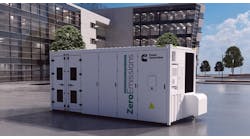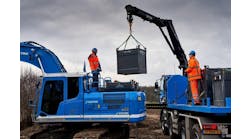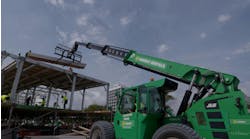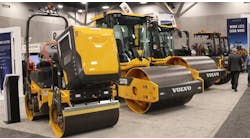Tim Ford joined Genie Industries a year and a half ago as CEO, and has grown along with the company. RER editor Michael Roth had the opportunity to sit down with Ford at the ARA show, and in this candid interview with RER, Ford analyzes the company’s continuing international growth and manufacturing capability around the world.
RER: It looks as though Genie is continuing on a strong growth path.
Ford: For me this has been a great experience to have the opportunity to lead a company that has the position in the industry and the people and the prospects for long-term growth. In the end, I don’t care what you sell, if you don’t have an organization with great people, you don’t have anything. This organization continues to amaze me with the quality of people who have been here and the people that come into the company, whether it’s at my level or throughout the organization. There’s almost a breeding effect that happens when people adapt to the fact that we are about the customer, for the customer and responsive to their needs. If that’s not the personality of the person that comes in, they either adapt to it or they don’t stay.
Saying thank you to the customer for their business is not a hard thing to do, but it’s very meaningful. People want to feel that if they spend their hard-earned dollars that people care.
Tell us about the acquisition of Phoenix Equipment Co.
We went through a process last summer as an organization to figure out, “Where do we want to take the business?” We’ve had three or four years of fantastic growth, so what’s the next chapter for us? I took a team of about 80 people from around the world to look at strategy for us. And we came up with three critical areas for us. Globalize the business, extend our offering beyond equipment to include services, and extend our offering beyond aerials into a broader set of products, which might mean other Terex offerings or maybe other categories we’re not into yet.
Globalization is a key part of our business. We’ve historically been two-thirds in North America and one-third outside of North America. That revenue mix changed in 2007, partly because of the market demand, and partly because we were pushing it in that direction. So we’re closer to 55/45 in ’07 and so we’re beginning to manufacture products closer to the customer.
At the same time we said, in the last decade, there are probably about 10 times as many pieces of equipment in the field than there were 10 years ago, and with that installed base out there, there’s a big market for used equipment, customers are seeking different financial solutions to their cap-ex spend, it makes sense for us to get into refurbishments. We had a long-term relationship with Phoenix Equipment in Waco, Texas. So what we have been doing is we’ve been talking to a few select customers that wanted us to do the refurb and we were effectively outsourcing it to Phoenix. And so through a series of discussions, we decided that it was the right time and place for Phoenix and the right time and place for us to put this together and really to take this under our roof. So in January we concluded the acquisition of Phoenix Equipment. We will be more proactive in how we’re trying to sell refurb services to our customers if they want it.
This is part of a larger strategy to offer a variety of services to our channel partners and one of the things that is really important to me is to make sure that the message is crystal clear to our customers that our message is to support their business, not to compete with their businesses.
You are now manufacturing scissorlifts in the U.K. at the Coventry plant?
We’re manufacturing small scissorlifts there. It’s an amazing story. We designed the manufacturing line in Redmond, we tested it in Redmond, we broke it down, we shipped it to England, we assembled it in England and began production of scissors in November. So we went from no line, not even the idea of a line, to the same rates of production in England that we’re doing in Redmond in basically nine months. The team did a phenomenal job. We will produce between 20 and 25 percent of our unit volume for Europe in Europe. That includes the telehandlers out of Italy as well as scissors in Coventry.
Will you expand manufacturing to other areas?
We don’t have a plant in China yet, but that’s something we’re looking at. In my analysts’ presentation that’s also on the website, I had a slide that said that as part of our globalization strategy we intend to manufacture — by 2010 — 50 percent of our production in Europe for Europe, and 30 percent of our production in Asia for Asia. So we’re going to go from nothing to a substantial part of a region’s production by 2010.
On the one hand, it sounds like “Let’s just go build a plant,” but it’s pretty complicated. You’ve got supply chain, you’ve got infrastructure, those sorts of things you’ve got to build. But we’re committed to and aggressively pursuing that because for us to manufacture in the Pacific Northwest, put the product on a boat and ship it around to Europe or ship it down to Brazil or ship it over to Asia, depending on the location, it could be four to six weeks on the water and a lot of abuse in transit. It’s not a productive way for us to use our assets or to serve the customer.
Are you considering a plant in Brazil?
Brazil probably is a little further out, but I would say Europe and Asia are clearly in the sweet spot for where we are. Latin America is a small market for us today but growing very, very rapidly. I was in Brazil in November and I was just really impressed at how that market is growing from basically nothing to a pretty substantial market pretty quickly.
Will you be able to leverage some of the strengths of being part of Terex in developing manufacturing capabilities?
I would say more so in Europe than in Asia Pacific so far. In Europe, using the Coventry facility, we tap into their supply chain, their supplier base. We have an aggressive plan for developing a plant somewhere in Europe that would be a significant facility and we would utilize a lot of infrastructure that’s in place today.
It seems as though competition is once again increasing in the aerial business.
A growing profitable business attracts players and I think that’s what we have here, a business that has long-term potential for growth and is profitable for the manufacturer and the rental company. The same can also be said for the rental channel, the people to whom we sell as well, there are many people that sold their companies and sat on the sideline for several years and are now starting up again. It’s a profitable business for the operator and it’s also a profitable business for the manufacturer. Any time you have that kind of scenario, it attracts capital and that’s really what’s happening at this point. The challenge for us is to make sure that we have a really good value proposition that customers want, with availability at a timely manner at the right price and hopefully be able to either maintain or grow our market share. That’s really what my challenge is a year and a half into the role: to make sure we are investing in the right ways to stay in front of those kinds of things.
It gets back to the point that buying the least expensive piece of equipment isn’t the most economic way to go in the long run.
Exactly. It’s the total cost of ownership, it’s the total investment against the total return. We need to be able to demonstrate to the customer that when they do business with Genie, they make more money. That really to me is the essence of what we need to show people. And every day, the bar gets raised. The customer has higher expectations and our customers are creative and capable and confident as well and our challenge is to make sure that we are staying in front of customer needs, never getting arrogant, never taking the customer for granted, and making sure that we are satisfying their needs with the things that they value.
How does the economy look to you?
I get asked this question all the time, particularly from the financial community. It’s really interesting to me — the headlines you read in the newspaper and the comments that you hear when you’re talking to customers are totally inconsistent. If you read the newspaper, it’s doom and gloom, yet when I talk to customers here, they say that utilization rates are high and their rental rates are decent. They are cautious, but the overall world our customers are serving seems relatively OK. It’s not robust, it’s not like 2005 and 2006, but it’s decent.
Are you concerned about the non-residential construction slowing down in response to residential?
Sure, and I think it’s reasonable to assume that will happen. But what that means, and how that will play out, I’m not smart enough to know. I really believe we’re in a growth space. The utilization of aerial work platforms will continue to grow around the world for the next decade. Infrastructure needs and requirements are growing, the world’s population is increasing, economies are improving in countries like China, and Brazil and Mexico and India, and all of that breeds the needs for roads, buildings, schools, hospitals and all of that. That’s all good for the kinds of products that Terex makes and as governments start requiring stricter requirements on work safety regulations, we’ll continue to see more applications and use of aerial work platforms in a variety of different spaces.
What I can’t pinpoint is what the third quarter of this year or the third quarter of that year will be like. But the beginning and the end point I’m pretty confident about.
According to the U.S. Census Bureau, the population of the U.S. alone will grow by 65 million by 2030.
If you look at it on a global basis, there are about 6 billion people in the world today, the forecast is for 9 billion people in the world by 2050. Even if they’re half off, or half right, you’re going to have more people in 2050 than you have in 2006 or 2007 and it’s going to require more infrastructure. So I like the space that we’re in.





